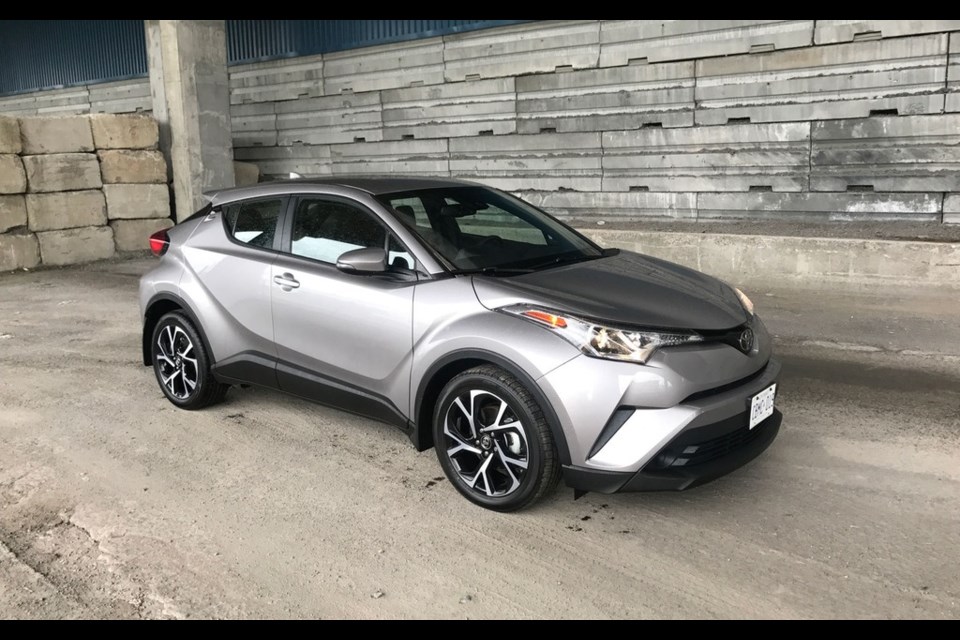The last couple of years have seen a surge in automakers jumping into the subcompact crossover market with offerings such as the Mazda CX-3, the Honda HR-V, the Nissan Qashqai and, now, the Toyota C-HR. C-HR stands for Compact High Rider and the vehicle is built using Toyota’s New Global Architecture, which is something the company describes as “sharing their vehicles’ highly functional core components to accentuate appeal.” Got it.
The first thing one notices about the C-HR is its looks. Toyota has given this vehicle a wacky design which will ensure it stands out from the pack. As with all such designs, there are surely some who’ll be turned off, but the vehicle is being aimed at the young urban hipster crowd who desire to be different, so it likely fits the bill here.
The big, beefy front fascia gives the C-HR that desirable SUV look. A large crease on the vehicle’s flanks connects the headlights to the taillights, as part of the widebody-style flared fenders. I have to say I really do appreciate what Toyota has been able to do with this design. My background is writing about tuner cars where people custom-mould fiberglass body kits to their vehicles in order to replicate this look—and often to questionable results.
The rear of the vehicle is equally as interesting with a roof spoiler extending out over the rear glass and boomerang-style taillights. The rear door handles are located near the roof, making it somewhat difficult for a child to open, but other than that they still do the job fine. All in all, the C-HR is wacky, but I love it. I’m all for automakers making bold design moves and this one is certainly bold.
The interior of the 2018 Toyota C-HR pleasantly surprised me with the comfort and level of quality. Toyota is known for quality, but they’ve also been known to produce some pretty barebones stuff at the entry-level end of the spectrum. I had feared this might be one of those cases, but alas, I was proven wrong. The materials were of surprisingly good quality with beautiful black piano dash trim, a leather wrapped steering wheel and an aluminum shift knob—all standard features.
Even the plastic panels seemed to be a cut above what one should expect to find in a vehicle at this price point. The layout is functional and easy to use, except for the volume knob which is out of reach unless you lean toward the dash. You’ll enjoy the large infotainment screen and even the backup camera which Toyota integrated into the rearview mirror. The vehicle is roomy enough given its size, but three adults in the rear will still be a tight squeeze.
Unfortunately, a huge downside is that several features are missing, such as available navigation, Apple CarPlay and Android Auto. Toyota feels that most people just use their smartphones to navigate (I’ll admit I much prefer my phone as well), but why not add the ability to get these applications on the display screen using CarPlay or Android Auto? The move is especially puzzling given the target market of hipsters and millennials.
The C-HR also has a huge question mark on the powertrain side in that there is no all-wheel-drive option. This is strictly a front-drive vehicle unlike most of its competitors. Again, Toyota didn’t feel the hipster would care about traction in poor driving conditions, but I must admit I’m puzzled by the move. Between the lack of all-wheel drive and lack of navigation, the C-HR is sure to lose some potential buyers to the competition.
The 2018 Toyota C-HR makes up some ground with its driving experience. Toyota has taken great pains to deliver a smooth and precise ride with this new architecture and it shows. It feels very sturdy on the road and handling is equally precise. The small 144-horsepower, 2.0-litre four-cylinder engine is quite good and propels the C-HR to highway speeds with little effort. Executing passes on the highway can be done with decent confidence and the power band is smoother than the Nissan Qashqai I just tested.
There are actually relatively few trim levels or options for the C-HR. The base XLE starts at $24,690 before freight and delivery charges, or you can opt for the XLE Premium for $26,290. For comparison, the Qashqai starts at just $19,998, the Mazda CX-3 at $19,995 and the Honda HR-V at $21,350. Of course, when these vehicles are similarly equipped, the price points align and few buyers will opt for the barebones version anyway, so it’s not that big of an issue. Being able to market such a vehicle at a sub-$20,000 starting price, however, gets people interested.
I enjoyed my week with the C-HR. The quality and craftsmanship impressed me, as did the drive, but the missing features would prompt me to really verify the competition should I ever find myself in the market for one.



